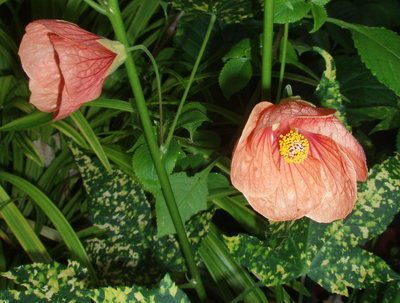
Raindrops on roses and clusters of cherries,
Bright copper grasses and ripe, juicy berries,
The fragrance of jasmine on warm summer evenings —
These are a few of my favorite things.
Ruffled begonias to light up the shade,
Orange and pink sunsets just before they fade,
The sight and sound of hummingbird wings —
These are a few of my favorite things.
Some of my other favorite things include plants with variegated foliage — foliage that grows in several different colors — such as Abelia Kaleidoscope or Confetti. The first sports gold-and-green leaves as a pretty backdrop for the white bell-shaped flowers that attract hummingbirds with their nearly year-round nectar. Confetti has creamy white variegated leaves that turn maroon in cold weather. Both are showy, compact plants 2 to 3 feet tall by about 4 feet wide.
Hebe Tricolor is another of my favorite variegated shrubs. This 3-foot beauty has colorful leaves of burgundy, creamy white and green. As an added bonus, it blooms with violet flower spikes in summer. It’s easy to grow in full- or half-day sun with good drainage and regular water. This evergreen shrub is perfect as an accent or in a mixed border.
I like all abutilons. You may know them as flowering maple or Chinese lantern. With pink, red, yellow, orange or white flowers, I like them all. Those with variegated foliage always catch my eye, though. Some are strikingly variegated, with creamy yellow or white patterns in the leaves. Others look as if taxi-cab yellow paint had been splattered on their leaves. Abutilons bloom continuously throughout the season and are a favorite of hummingbirds.
Pick your veggies
Out in the vegetable garden, don’t slack off picking your ripening produce. It’s an easy thing to do with the distraction of summer heat and vacations. Your veggies, on the other hand, want nothing more than to reproduce.
The summer solstice signaled to plants that days are getting shorter and to stop concentrating on new stems and leaves. Instead, shortening days say they’d better get to flowering and fruiting, for the season will be ending all too soon.
Pick veggies every day, if need be. Even one zucchini allowed to grow too big and ripe can tell the plant its job is done and the seeds are mature enough to ensure next year’s crop.
Your goal as a gardener and picker is never to let that seed form, so that the plant is tricked into producing more flowers and fruit in its never-ending quest to reproduce. This is the secret to keeping your plant hard at work for as long as possible. Even if you don’t eat it, pick it anyway and give it away.
Marigold pest control
Questions frequently pop up about marigolds. Do they help with pest control, and which type is the best?
Like other members of the daisy family, marigolds provide nectar to beneficial insects, such as syrphid flies, which prey on aphids and other insects that attack garden plants. Parsley and dill flowers are even better, but daisy-family flowers keep the nectar flowing longer.
Marigolds have been shown to have some slight effect in repelling cabbage worms. A variety called Stinking Roger repels flies that bother cows and other domestic animals, but I’ve never seen that marigold available around here.
It’s the common French marigold that has been shown to control nematodes. You need to plant them thickly as a cover crop and allow them to grow for many weeks to be truly effective.
Gem marigolds are a favorite food of slugs and Japanese beetles and can act as trap plants. On the other hand, they might just attract more of those pests than the garden would have had otherwise.
So now you have the rest of the story. The bottom line: Plant marigolds because they do have some beneficial effects, but mostly because they’re pretty.
Jan Nelson, a California certified nursery professional at Plant Works in Ben Lomond, will answer questions about gardening in the Santa Cruz Mountains. E-mail her at ja******@*ol.com.










